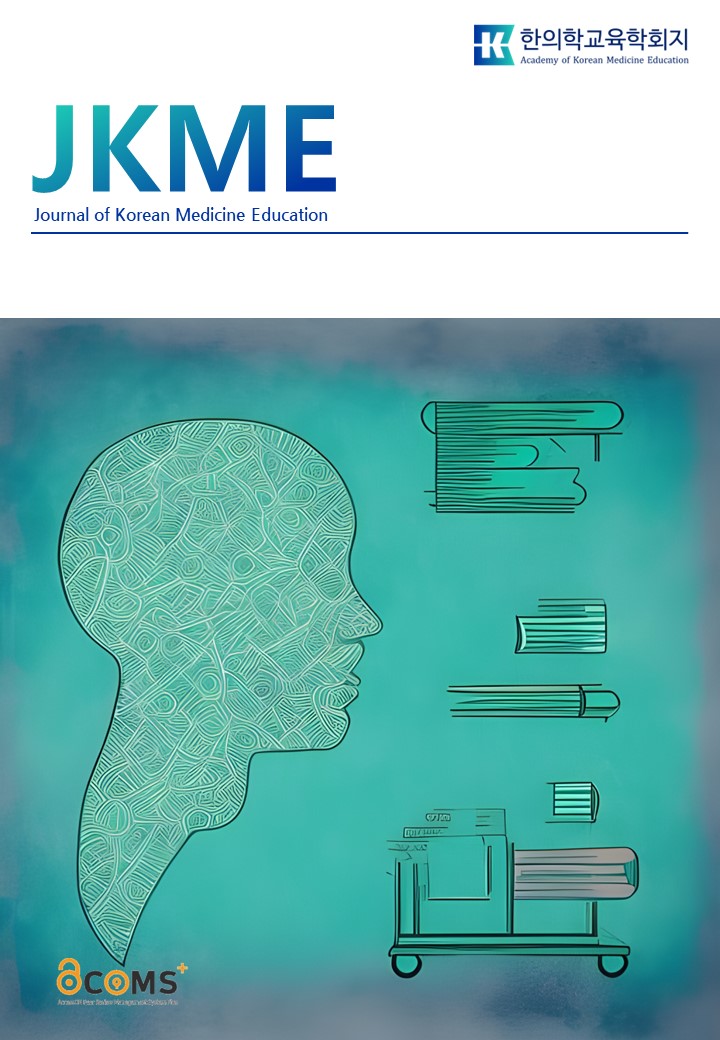- KOREAN
- E-ISSN2983-3973
 E-ISSN : 2983-3973
E-ISSN : 2983-3973
Vol.1 No.1
Abstract
Background: Specific methodologies and application examples are required to make Item Response Theory (IRT) analysis more accessible for competency-based learning and personalized education in the field of traditional medicine education practice. The purpose of current study was to analyze the test and item validity along with the competency characteristics of four subjects in a mock National License Examination (NLE) as a representative showcase. Methods: The 3-parameter IRT was used to analyze the pediatrics, preventive medicine, physiology and herbology subjects of mock NLE. The Test Character Curve (TCC), Test Information Function (TIF), and Test Standard Error Curve (TSE) were used to assess test validity, and the Wright map was used to attest item and test validity. Kernel density map was used to analyze the characteristics of competencies by gender and academic administration groups. Results: TCC, TIF, and TSE, along with Wright map, provided intuitive understanding of test and item validity, and showed distinctive differences between subjects. The Kernel density map revealed group-specific competency characteristics for evidence-based personalized student management. Discussion and conclusion: A practical learning analytics methods using IRT were presented, which can be easily utilized in the field of medical education. Systematized regular academic analysis and individualized student management with basic comprehensive assessment and NLE could be useful for improving the quality of evidence-based competency-based education in traditional Korean medicine.
Abstract
This mini-review focuses on the intense competition in grades and the concerns of students within Korean medicine colleges. It explores the importance and suitability of student evaluation methods, with a specific focus on criterion-referenced assessment. This method supports outcome-based education and helps nurture students' competencies. The paper clarifies the differences between criterion-referenced and norm-referenced assessment, explains the key principles and significance of criterion-referenced assessment, and highlights its role in supporting outcome-based education. Furthermore, it discusses the factors to consider when implementing criterion-referenced assessment in colleges of Korean medicine. Lastly, the paper addresses the challenges associated with adopting and using criterion-referenced assessment in these institutions.
Abstract
Background: The necessity of clinical teaching that enables students to encounter real patients before becoming doctors of Korean Medicine has risen to achieve clinical competency. In this study, we present the intention of designing a manual of extracurricular practice in which a student doctortreats a real patient, also a Korean Medicine student, involved in the training program. Methods: We referred to the rapid prototyping of an instructional systems design model to analyze the needs of stakeholders in an existing training program, identify solutions, and design a manual for instructors and organizers of the program. We discussed the current (as-is) and ideal (to-be) education at stakeholder meetings. Information about the existing programs was collected and analyzed. We analyzed the causes of the significant performance issues and derived solutions for designing a program manual. Based on this manual, we implemented the program four times during the first semester of 2022. Results: The expected objectives of the program were: For student doctors to develop clinical reasoning with a therapeutic approach and for patients to learn by experiencing Korean medicine treatment. Different objectives for different grades were set for observers. The primary problem was that the student doctors were concerned about performing clinical practice in front of many students. To address this issue, pre-training for student doctors included practicing history taking, charting medical records, and patient presentations. We developed a program timetable, stakeholder roles, and documents required for the program. Discussion and conclusion: This program, which enables students to learn through the care of a single patient, was designed to strengthen their competencies beyond the optimal patient care required by doctors of Korean Medicine. This program is a format of peer-assisted learning in which student doctors are teachers, and patients and observers are learners. Further studies are needed to promote the participation of real patients in Korean medical education so undergraduates can practice in actual clinical situations.
